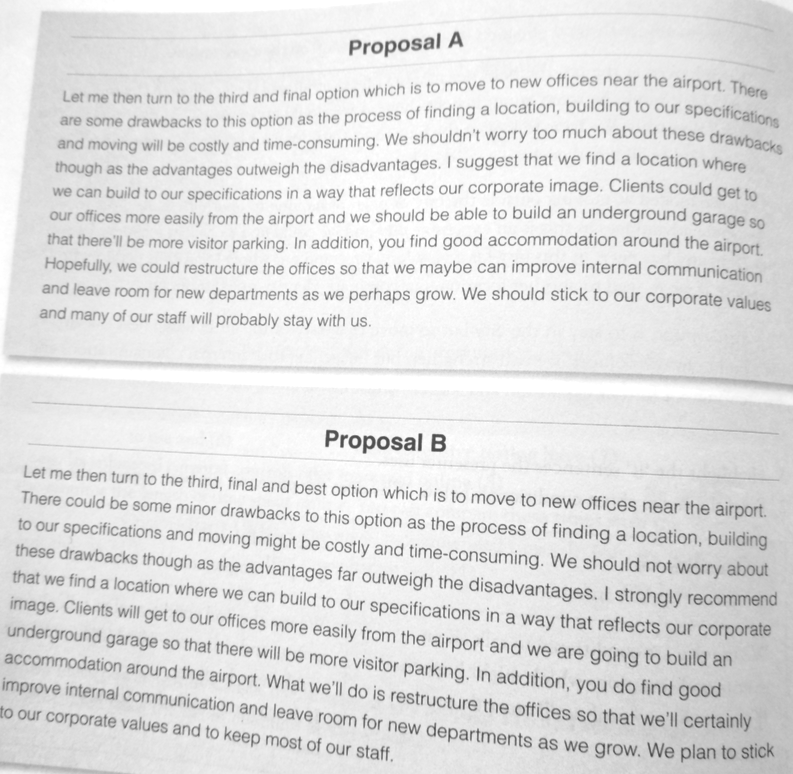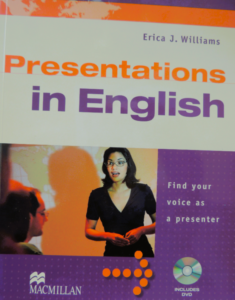Students can quickly and easily improve the delivery of their presentations by varying PACING – not saying everything at the same speed – and INTONATION – using EMPHASIS to draw the listeners into their key points and most important information so as to clarify intention and meaning.
9 Step Plan
Here is a lesson plan that can help you to teach some vital skills that can make all the difference.
- Students watch this video which outlines 5 Quick Tips to improve delivery:
This video covers the use of:
- full forms instead of contractions
- auxiliaries
- “what” at the beginning of a sentence or point
- vocabulary
- the “be going to” form to express future plans and intentions.
2. Read these two proposals aloud to the students without them having the text in front of them. This exercise is tucked away on page 64 in Step 5 of my book “Presentations in English”:

Proposal A and Proposal B are basically the same proposal but some small twists in Proposal B make it more convincing.
3. Ask which proposal is most convincing. It is highly likely that students will say B. (To be honest, I’ve never heard a student give A as the most convincing).
4. Ask WHY the students found this proposal more convincing and find out what they have recognised by listening.
5. When all the answers have been given, then give students the opportunity to read the texts and find further points if necessary.
The students should recognise:
- The use of the full form of contracted words:
“we should not worry”
“there will be more visitor parking”.
- The use of auxiliary verbs for emphasis:
“you do find good accommodation …”.
- The use of “what” at the beginning of a sentence:
“What we’ll do is ..”.
- The elimination or replacement of tentative “wishy-washy” language when it is not appropriate:
“we perhaps grow” – “we grow”
We should stick to our corporate values” – “we plan to stick to our corporate values”
“clients could get to our offices” – “clients will get to our offices”.
- The addition of adjectives and adverbs:
“let me turn to the third, final and best option”
“the advantages far outweigh the disadvantages”
“I strongly recommend”.
- The switch of “will” future form for “be going to” future form:
“we are to going to build an underground garage”.
6. Read Proposal B out aloud once more or have a student or students do this.
Demonstrate that pacing – slowing down important points – “the advantages ….(short pause of one or two seconds) …far … (short pause of one or two seconds) … outweigh the disadvantages” and stressing key words “FAR outweigh” also help to draw the listener in.
These small changes make all the difference to the proposal. They are not difficult from a language point of view and it will be very easy for your students of English to integrate such subtle changes in their own presentations. Encourage them to do so by following the next steps.

7. Do the exercises B, C and D on pages 64 and 65 in “Presentations in English” to consolidate the learnings. (If you don’t have the book, then skip to 8.)
8. Then, get students to prepare a part of a presentation – this could be the start, finish or a point in a presentation – and integrate some or all these small changes.
9. Students present their part presentations. Encourage them to have fun and go “over the top”. Give feedback.
Final Words
Like so many other aspects in presentations, practice can feel forced and a little “inauthentic” at first but I can guarantee it will not take long for students to start implementing small incremental changes in their own presentations. The “inauthentic” will become “authentic” and part of the students’ repertoire.
